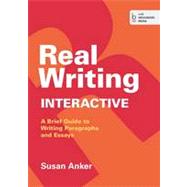Real Writing Interactive offers practical coverage of writing skills and step-by-step guidance on crafting paragraphs and essays in a brief, interactive, and affordable format. The print component offers the essentials of Anker’s accessible writing instruction along with select exercises; additional exercises are available online in LearningCurve, adaptive, game-like quizzing that helps students focus on the material they most need help with. As with all books in the Anker series, Real Writing Interactive motivates students with its message that writing is an essential and achievable skill and encourages students to connect what they learn with their own goals and with the needs and expectations of the larger world.








